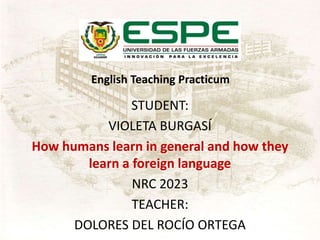
How humans learn in general and how they learn a foreign language
- 1. English Teaching Practicum STUDENT: VIOLETA BURGASÍ How humans learn in general and how they learn a foreign language NRC 2023 TEACHER: DOLORES DEL ROCÍO ORTEGA
- 2. HUMAN LEARNING Steps about How human beings learn 1. Specify entry behavior. 2. Formulate explicity 3. Devise some methods of training. 4. Sort of evaluation procedure. Learning and Training
- 3. PAVLOV’S CLASSICAL BEHAVIORISM Ivan Pavlov Classical conditioning Russian Psychologist Associations between stimuli Reflexive responses
- 4. SKINNER’S OPERANT CONDITIONING Behavior thats elicited by preceding stimuls Behavior of Organism neobehaviorist Unique dimension to behavioristic psychology. Operant behavior One “operates” on the environment within this model. The importance of stimuli is deemphasized. OPERANTS: - Crying - Sitting down - Walking - - baseball Sets of responses that are emitted and governed by the consequences they produce.
- 5. AUSUBEL’S SUBSUMPTION THEORY Learning take place in the human organism throgh A meaningful process of relating new events or items. The acquisition of: - New meanings (knowledge) - - retention - - psychological organization. Hierarchical structure
- 6. ROTE VS MEANINGFUL LEARNING Cognitive theory Rote learning Meaningful learning Subsumption Process of relating and anchoring new material to Established entires in cognitive structure. Mental storage of items. Little or no association with existing cognitive structure.
- 7. BEHAVIORISTIC COGNITIVE CONSTRUCTIVIST Classical Operant Pavlov Skinner Ausubel Rogers - Respondent conditioning - Elicited responce S→R - Governed by consequences - Emmited response R→S (reward) - NO punishment Programed instruction Meaningful= Powerful Rote=weak Subsumption Association Systematic forgetting Cognitive “pruning” - Fully functioning person - Learn how to learn - Community of learners - Empowerment THEORIES OF LEARNING
- 8. TYPES OF LEARNING • Human being learn learns to make a diffuse responde to a signal. • Classical response of Pavlov. 1. Signal learning • Learner acquires a response to a discriminate stimuls. • Instrumental response. 2. Stimuls-response learning • What is acquired is two or more stimuls-response connections. • By Skinner 3. Chaining • Learning of chains that are verbal. • Motor chains. 4. Verbal association
- 9. TYPES OF LEARNING • Although the learning of each stimuls –response connection is a simple occurrence. • The connections tend to interfere with one another. 5. Multiple discrimination • Learner is able to make a response that identifies an entire class of object of events. . 6. Concept learning • A principe is a chain of two or more concepts. 7. Principle learning • Kind of learning that requires internal events usually referred to as “thinking” . 8. Problem solving
- 10. SECOND LANGUAGE LEARNING • Ocurrs in the total language process. • Responde of some kind (emotionsl, cognitive, verbal or non verbal) to language. 1. Signal learning • Through a process of conditioning, trial and error, the learner makes closer and closer approximations to a native pronuntiation. 2. Stimuls-response learning • Chaining appears in acquisition of phonological sequences and syntactic patterns.3. Chaining • Gagne’s distinction between verbal and nonverbal chains. 4. Verbal association
- 11. SECOND LANGUAGE LEARNING •These are necessary in second language learning. •A word has to take on several meanings •A rule in the native language is reshaped to fit a SL context. 5. Multiple discrimination •Language and congnition are inextricably interrelated. •Rules of syntax and conversation are linguistic concepts that have to be acquired. 6. Concept learning •Rules are not isolated in rote memory. •Extension about formation os a linguistic system. 7. Principle learning •Solutions to the problems involve the creative interaction with previous information and knowledge in order to correctly determine the meaning of word. 8. Problem solving
- 12. TRANSFER Positive transfer Negative transfer Transfer of knowledge prior to subsequent learning. Prior knowledge benefits the learning task. Past or previous performance interrupts the performance of the second task.
- 13. Interference It Is when a previous item is incorrectly transferred or incorrectly associated with a item to be learned He will use whatever previous experience he or she has had with language to facilitate the second language learning process EXAMPLE:
- 14. Overgeneralization • Independently of the native language the apprentices will generalize a particular rule in the second language. • Occurs when the second language learners acts within the target language.